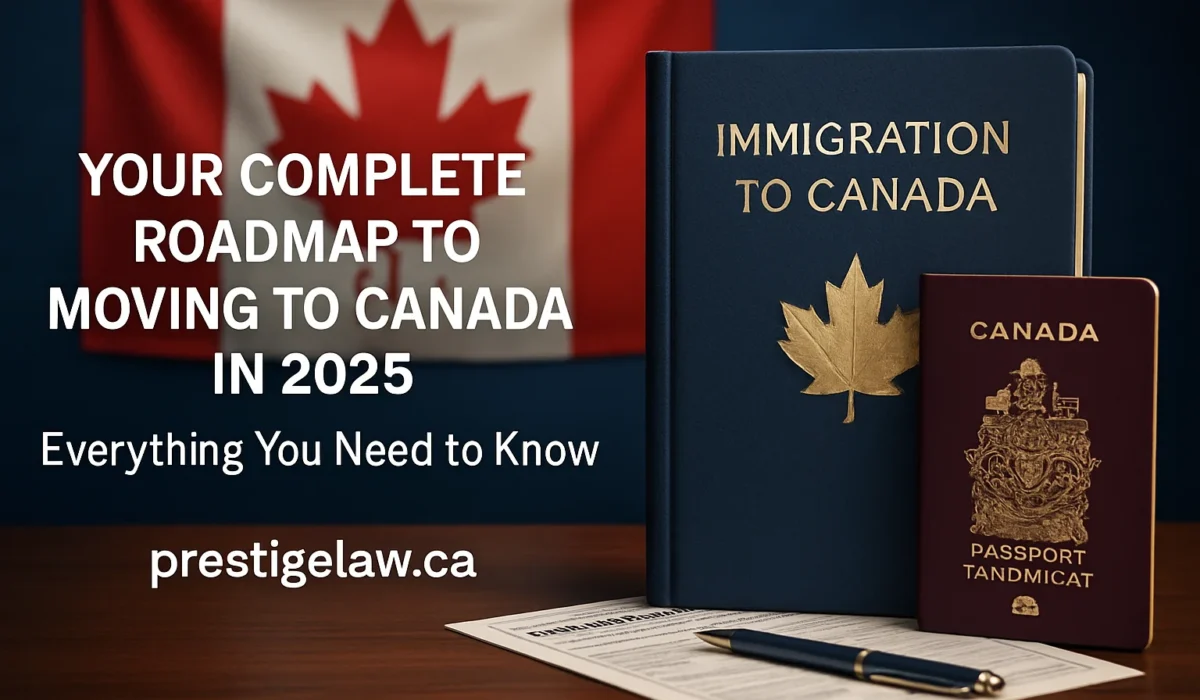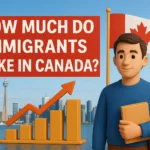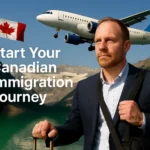Your Complete Roadmap to Moving to Canada in 2025: Everything You Need to Know
Are you planning to move to Canada in 2025? You’re not alone. With its welcoming immigration policies, world-class healthcare, excellent education system, and high standard of living, Canada remains a top destination for immigrants around the globe.
However, navigating the Canadian immigration system isn’t always easy. From selecting the right immigration program to preparing your documents and planning your finances, there are many steps involved. This comprehensive guide breaks down everything you need to know step-by-step.
1. Understanding Canadian immigration System and Your Options
1.1 Federal Immigration Programs Overview
Express Entry and Its Three Streams
Canada’s Express Entry system is the fastest and most popular way to immigrate as a skilled worker. It manages applications for three federal economic immigration programs:
- Federal Skilled Worker Program (FSWP): For applicants with at least one year of foreign work experience.
- Federal Skilled Trades Program (FSTP): For skilled tradespeople with at least two years of work experience.
- Canadian Experience Class (CEC): For individuals with at least one year of skilled work experience in Canada.
Applicants are ranked using the Comprehensive Ranking System (CRS), and the highest-ranking profiles receive an Invitation to Apply (ITA).
Provincial Nominee Program (PNP) Basics
Each Canadian province (except Quebec) operates its own Provincial Nominee Program to address local labor shortages. You can apply:
- Directly to a province (non-Express Entry stream)
- Through Express Entry if you are nominated under a province’s Express Entry-linked stream (adds 600 CRS points)
Popular PNPs include those from British Columbia, Ontario, Alberta, and Saskatchewan.
Quebec-Specific Immigration Process
Quebec runs its own skilled worker immigration process. You must apply to:
- The Government of Quebec through programs like the Regular Skilled Worker Program (RSWP) or Quebec Experience Program (PEQ).
- IRCC after you’ve received a Quebec Selection Certificate (CSQ).
Language proficiency in French is often required.
1.2 Popular Immigration Pathways for Different Situations
Skilled Worker Programs for Professionals
Ideal for professionals in high-demand sectors like tech, engineering, and healthcare. Most skilled workers apply through Express Entry or a PNP stream.
Family Sponsorship Requirements and Timelines
If you have a Canadian citizen or permanent resident relative, you may qualify under family sponsorship. Eligible relationships include:
- Spouse or common-law partner
- Dependent children
- Parents and grandparents
Processing can take 12–24 months, depending on the relationship and country of origin.
Student and Work Permit Pathways to Permanent Residence
Studying or working in Canada can pave the way to PR:
- Study Permit → Post-Graduation Work Permit (PGWP) → Express Entry or PNP
- Employer-sponsored work permits may also lead to PR through CEC or PNP pathways.
1.3 Eligibility Requirements and Points Systems
Comprehensive Ranking System (CRS) Scoring
CRS scores are based on:
- Age
- Education
- Language proficiency
- Work experience
- Canadian education/work experience
- Provincial nomination or job offer
Typical CRS cut-offs range from 470–550, but vary with each draw.
Language Proficiency Requirements
You’ll need to prove English or French ability with approved tests:
- IELTS General Training or CELPIP (English)
- TEF Canada or TCF Canada (French)
Minimum score for Express Entry: CLB 7 or higher (higher scores increase CRS).
Education Credential Assessment (ECA)
If your education was completed outside Canada, you must get an ECA report from an approved organization like WES or ICAS. This confirms your credentials meet Canadian standards.
2. Planning Your Move: Timelines, Costs, and Documentation
2.1 Creating a Realistic Timeline for Your Immigration Journey
Here’s a general timeline (Express Entry example):
| Step | Duration |
| Language test and ECA | 1–2 months |
| Creating profile & ITA wait | 1–6 months |
| Submitting PR application | Within 60 days of ITA |
| PR processing | 6–12 months |
Plan for delays due to incomplete documents, biometrics, or medicals. Keep backups and check application updates regularly.
2.2 Financial Planning and Cost Breakdown
Government Fees (Per Adult Applicant):
- ECA: $200–$300
- Language Test: $300–$350
- PR application: $1,365 (includes Right of Permanent Residence Fee)
- Biometrics: $85
- Medical exam: $150–$300
- Police clearance: $20–$100 (varies by country)
Settlement Funds Required (2025):
- 1 person: $13,757
- 2 people: $17,127
- Family of 4: $25,564
These funds must be readily available and not borrowed.
Hidden Costs to Budget:
- Airfare and baggage
- First month’s rent and deposit
- Furnishing your home
- Winter clothing (if coming from a warmer climate)
- Childcare or school supplies
2.3 Essential Documents and Paperwork Preparation
Required documents:
- Valid passport
- Educational certificates + ECA
- Language test results
- Work experience letters
- Police clearance and medical reports
- Marriage/birth certificates (if applicable)
Documents must be:
- Translated into English/French (if needed)
- Certified and authenticated
Organize your documents into clearly labeled folders and keep digital backups.

3. Choosing Where to Live: Provinces, Cities, and Communities
3.1 Provincial Comparison: Opportunities and Lifestyle Differences
Each province offers a unique mix of job markets, climate, and lifestyle:
| Province | Highlights |
| Ontario | Strong economy, diverse cities, tech and finance jobs |
| British Columbia | Beautiful nature, coastal climate, growing film and tech sectors |
| Alberta | Low taxes, oil and gas sector, affordable housing |
| Quebec | French-speaking, cultural heritage, competitive tuition |
| Atlantic Provinces | Slower pace, PNP-focused on population growth |
3.2 Major Cities vs. Smaller Communities
Big Cities:
- Toronto: Diverse, fast-paced, high cost of living
- Vancouver: Mild winters, expensive real estate
- Montreal: Bilingual, affordable housing
- Calgary: Low taxes, energy sector jobs
Smaller Towns:
- Lower rent and housing prices
- Tight-knit communities
- Regional immigration pilot programs
3.3 Housing Market Overview and Accommodation Options
- Rental Costs: $1,500–$3,000/month depending on city and apartment size
- Buying Property: Prices vary widely by region
- Short-term stays: Airbnb, hotels, and hostels are options for your first month
- Lease Agreements: Most rentals require a 1-year lease, first and last month’s rent up front
4. Employment and Career Transition in Canada
4.1 Job Market Research and Industry Opportunities
In-demand occupations (2025 projections):
- Healthcare professionals (nurses, physicians)
- Software developers
- Construction workers
- Truck drivers
- Accountants and finance professionals
Research using:
- Job Bank Canada
- LinkedIn, Indeed, Glassdoor
- Local province-specific job boards
Understand Canadian workplace culture: professionalism, punctuality, clear communication, and inclusivity are valued.
4.2 Professional Credential Recognition and Licensing
Some regulated professions require licensing:
- Nurses: Through NNAS and province’s nursing college
- Engineers: Apply to provincial engineering body (e.g., PEO in Ontario)
- Teachers, trades, and health professionals often need bridging programs
Contact the respective regulatory authority in your province.
4.3 Job Search Strategies and Networking
- Use a Canadian-style resume (focus on skills, no photo)
- Write personalized cover letters
- Attend networking events and virtual career fairs
- Join LinkedIn groups, immigrant career programs
- Consider mentorship programs like TRIEC or ACCES Employment
5. Practical Steps for Your First Year in Canada
5.1 Essential Services and Government Registration
Once you land:
- Get your SIN (Social Insurance Number) – needed to work
- Apply for provincial health insurance (e.g., OHIP in Ontario)
- Open a Canadian bank account
- Apply for a credit card to start building credit
5.2 Education System and School Enrollment for Families
- Public schools are free for residents
- Private schools charge tuition
- For higher education: colleges offer practical diplomas; universities offer academic degrees
Credential transfer options are available for international students.
5.3 Integration and Community Involvement
- Take part in language classes (free ESL/FSL programs)
- Access settlement agencies for help (e.g., YMCA, COSTI)
- Attend cultural events and volunteer in your community
Final Summary
Moving to Canada in 2025 requires thorough research, strategic preparation, and realistic expectations. From understanding Express Entry and PNPs to choosing the right province, securing employment, and integrating into your new community every step matters.
Partnering with an experienced immigration law firm like Prestige Law can help you navigate this life-changing journey with confidence and success.
Frequently Asked Questions
How long does the entire immigration process typically take?
6 months for Express Entry to 2–3 years for PNP or family sponsorship.
How much money do I need to move to Canada?
$13,310–$34,000+ depending on family size, plus application and relocation expenses.
Can I work in Canada while my PR application is being processed?
Only if you hold a valid work permit. Applicants outside Canada typically cannot work until PR is approved.
Do I need to speak French to immigrate to Canada?
Not required for most programs (except Quebec). Knowing both languages boosts CRS points.
What happens if my application is rejected?
You may reapply after correcting issues, appeal in some cases, or explore alternative immigration programs.
How do I find housing before arriving in Canada?
Book short-term stays (Airbnb, hotels) for your first month, then look for permanent housing in person.
canadian immigration canadian immigration canadian immigration canadian immigration canadian immigration canadian immigratiion canadian immigration canadian immigration canadian immigration canadian immigration canadian immigration canadian immigration canadian immigration







